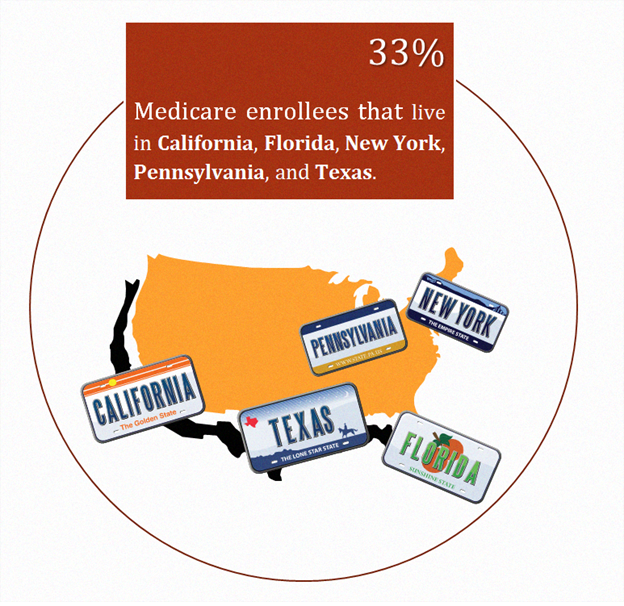Over a third of Medicare enrollees live in just five states—California, Florida, Texas, New York, and Pennsylvania—and it would appear, with higher populations and seemingly more medical options for people to choose from, those states may offer Medicare enrollees some financial advantages or reduced costs. But is that really the case?
Medicare spending per capita among the five leading Medicare states is not significantly different from Medicare spending per capita in other states across the country. In most cases, Medicare spending per capita fluctuates from a little under $10,000 to a little over $10,000 a year regardless of the state.
Some states, such as Alaska and Hawaii, spend significantly less per capita on Medicare, but there may—or may not—be environmental reasons for that. (For the general population, Alaska’s healthcare spending, per capita, is far above the national average.) In any case, the figures that matter most to Medicare recipients are not the amounts Medicare spends on their services, but the amounts Medicare does not spend.
Out-of-Pocket Costs
In the five leading Medicare states, as in the other states, out-of-pocket Medicare expenses are somewhat proportional to general per-capita healthcare expenditures. In other words, medical services in some states simply cost more than medical services in other states.
Among the leading Medicare states, per-capita healthcare spending is relatively low in Texas and California, somewhat higher in Florida, and significantly higher in Pennsylvania and New York. As a result, Medicare recipients in New York and Pennsylvania can often expect higher-than-average out-of-pocket costs associated with their Medicare coverage. This is not always the case, though, because of some state government programs designed to help people who would otherwise struggle to pay those costs.
For most people in all states, enrollment in private Medicare plans is a far greater factor in keeping out-of-pocket Medicare costs low. Nationwide, about 28 percent of states (14 states) have Medicare Advantage enrollment exceeding 30 percent of Medicare recipients. Among the five leading Medicare states, four of them—80 percent—have Medicare Advantage enrollment exceeding 30 percent. Only Texas falls short of the national average in Medicare Advantage enrollment.
Urban counties normally exceed the national average in per-capita enrollment in Medicare Advantage plans. There is plenty of disparity between certain urban and rural counties in the leading Medicare states when it comes to Medicare Advantage enrollment, but for the most part these high-population, urbanized states enjoy high enrollment rates in Medicare Advantage plans, and—at least for people covered by these plans—lower-than-average Medicare consumer costs.
The leading Medicare states are also well represented when it comes to enrollment in Medicare supplement plans. Residents of Texas and New York, especially, lean toward Medigap Plan F in their choice of Medicare supplement plans, which is a wise choice for most people. Average rates are competitive in these states, but rates are often just as low—and sometimes even lower—for Medicare consumers in states with smaller Medicare populations.
Overall, any minor disadvantages associated with living in states with smaller Medicare populations are more than offset by investing in Medicare plans best designed to meet the needs of individuals regardless of where they live.
Do you live in one of the five leading Medicare states? If so, how does that impact your costs?
© 2013 MedicareMall.com
